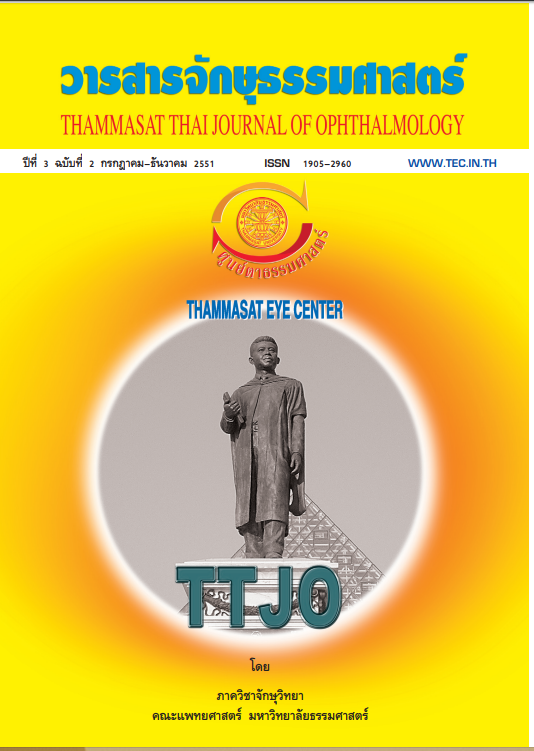ค่าสายตาผิดปกติในทารกเกิดก่อนกำหนดที่พบภาวะจอประสาทตาผิดปกติที่มีภาวะ threshold หลังการรักษาด้วยเลเซอร์
Main Article Content
Abstract
วัตถุประสงค์: เพื่อสึกษาผลของค่าสายตาผิดปกติ (refractive error) ในเด็กทารกเกิดก่อนกำหนดที่ตรวจพบภาวะจอประสาทตาผิดปกติ (retinopathy of prematurity; ROP) ที่มีภาวะ threshold และได้รับการรักษาโดยการยิงเลเซอร์โดยการใช้ laser indirect ophthalmoscope
วิธีการศึกษา: เป็นการศึกษาแบบย้อนหลัง (retrospective study) โดยการศึกษาเวชระเบียนในผู้ป่วยเด็ก threshold ROP ที่ได้รับการยิงเลเซอร์ด้วยวิธี laser indirect ophthalmoscope โดยใช้ Diode laser 810 nm และเลนซ์ 28 diopters ในโรงพยาบาลพระพุทธบาท ตั้งแต่ตุลาคม 2545 ถึงกันยายน 2549 แล้วทำการวัดค่าสายตา (refraction) และนำผลที่ได้มาวิเคราะห์เปรียบเทียบหาความสัมพันธ์ ผู้ป่วยจำนวน 18 ราย ทั้งหมดได้รับการวินิจฉัยว่าเป็น threshold ROP และได้รับการรักษาโดยการยิงเลเซอร์ ในจำนวน 18 ราย พบว่าเป็นชาย 12 คน หญิง 6 คน จำนวนตาทั้งหมดที่นำมาทำการศึกษาทั้งหมด 34 ตา เป็นตาขวา 17 ตา ตาซ้าย 17 ตา
ผลการศึกษา: น้ำหนักเฉลี่ยของทารกเกิดก่อนกำหนด (birth weight) เท่ากับ 1171.06 กรัม (± 254.13) อายุครรภ์แรกเกิดเฉลี่ยของทารก (gestational age) เท่ากับ 27.50 สัปดาห์ (± 2.40) อายุจริงของทารกเกิดก่อนกำหนด (post-conceptional age) ขณะได้รับการยิงเลเซอร์เฉลี่ยเท่ากับ 34.50 สัปดาห์ (± 2.52) อายุหลังเกิดของทารก (chronological age) เมื่อได้รับการยิงเลเซอร์เฉลี่ย 7.06 สัปดาห์ (± 2.31) จำนวนเลเซอร์ที่ได้รับการยิงในแต่ละตา (laser spot) เฉลี่ยเท่ากับ 1018.62 นัด (± 342.15) ช่วงอายุที่ได้รับการวัดสายตามีค่าเฉลี่ย 44.00 เดือน (± 8.80) ค่าสายตาผิดปกติ (refractive error) คำนวณเป็น spherical equivalent แล้วมีค่าเฉลี่ย -2.24 diopter (± 2.45) เมื่อเปรียบเทียบความสัมพันธ์ระหว่างจำนวนเลเซอร์ที่ยิงกับภาวะการเปลี่ยน แปลงทางสายตาที่ได้จากการวัดสายตาโดยไม่คำนึงถึงปัจจัยอื่นที่จะเป็นตัวแปร โดยใช้ Spearmanûs correlation analysis จะพบว่า จำนวนนัดเลเซอร์ที่มากชึ้นมีความสัมพันธ์กับค่าสายตาผิดปกติไปในทางลบมาก ขึ้น โดยมีคาสัมประสิทธิ์ความสัมพันธ์ (r) = -0.756 (P<0.001)
สรุป: จำนวนเลเซอร์ที่ใช้ในการรักษาภาวะ threshold ROP มีความสัมพันธ์กับภาวะค่าสายตาผิดปกติไปในทางสายตาสั้น (myopia) ซึ่งอาจจะมีปัจจัยอื่น ๆ ที่เป็นสาเหตุดังรายงานการวิจัยอื่น ๆ ที่มีก่อนหน้านี้แล้ว
Refractive Error in Premature Infants after Treatment with Laser Photocoagulation for Threshold Retinopathy of Prematurity
Objective: To evaluate the refractive error after treatment with indirect laser photocoagulation for threshold retinopathy of prematurity (ROP) in premature infants
Methods: A retrospective study of infants with threshold ROP who were treated with indirect laser photocoagulation between October 2002 and September 2006 in PhraphutthabatHospital was conducted. Cycloplegic refractive error was assessed at post treatment follow-up visit. Thirty-four eyes of 18 infants (12 male, 6 female) were included in this analysis.
Results: The average birth weight was 1171.06 gram (± 254.13). The average gestational age was 27.50 weeks (± 2.40). The average post-conceptional age was 34.50 weeks (± 2.52). The average chronological age that had laser treatment was 7.06 weeks (± 2.31). The average number of laser spot was 1018.62 (± 342.15). The average age that had refraction was 44 months (± 8.80). The mean spherical equivalent cycloplegic refraction were -2.24 diopter (± 2.45). Spearmanûs correlation analysis was significant between numbers of laser spot and refractive error changes (r= -0.765; p<0.001).
Conclusion: The prevalence of myopia appears to be increased with the numbers of laser spot for treatment in infants with threshold ROP. However, other confounding factors may affect this finding.


